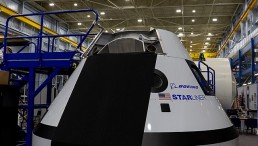ESA
NASA Orbiter Detects Ultraviolet Auroras on Mars
China's Lunar Rover Reveals Moon's Complex Geological History
Researchers Find How Acidified Oceans Have Become with Help of NASA and ESA Satellites
Ash, Auroras or Clouds—What Could this Strange Martian Plume Be?
ESA Mars Express Orbiter Reveals Place for Caffè on Mars’ Southern Icecap
Seeing In Shades of Red—Revealing the Rings of Saturn
Stellar Duo Fated to Meet a Supernova End—Twin Stars Discovered in Henize 2-428
Fire Starter—ESA’s Planck Satellite Reveals Later Star Formations
Three Moons Cast Shadow on Striped Gas Giant—Jupiter
Hubble’s New View of the ‘Pillars of Creation’
SpaceX’s Reusable Rocket Could Turn the Tide of Space Missions in 2015
Looking Back on 2014: NASA Marks the Top Discoveries of the Year
Must See: 5 Months in Space Compressed into 6 Minutes
ESA’s Philae Lander May Take the Prize, But Here Are 9 Other Breakthroughs of 2014 Also Worth the Award
Most Popular

Alexander the Great's Bathroom From 2,300 Years Ago Where Young Ruler Could Have Bathed With Companion Discovered by Archaeologists in Royal City of Aigai

Transparent Animals? These Weird Creatures Allow You To See Right Through Them

ESA Solar Orbiter Snaps Footage of Fluffy Plasma Structures of the Sun in Great Detail [WATCH]

Earth's Magnetic Field Nearly Collapsed 600 Million Years Ago, Sparking Evolution of More Complex Life

![Venus Lost Water and Dried Out Due to Chemical Reaction HCO+ Dissociative Recombination [Study]](https://1721181113.rsc.cdn77.org/data/thumbs/full/53493/258/146/50/40/venus-lost-water-and-dried-out-due-to-chemical-reaction-hco-dissociative-recombination-study.jpeg)



